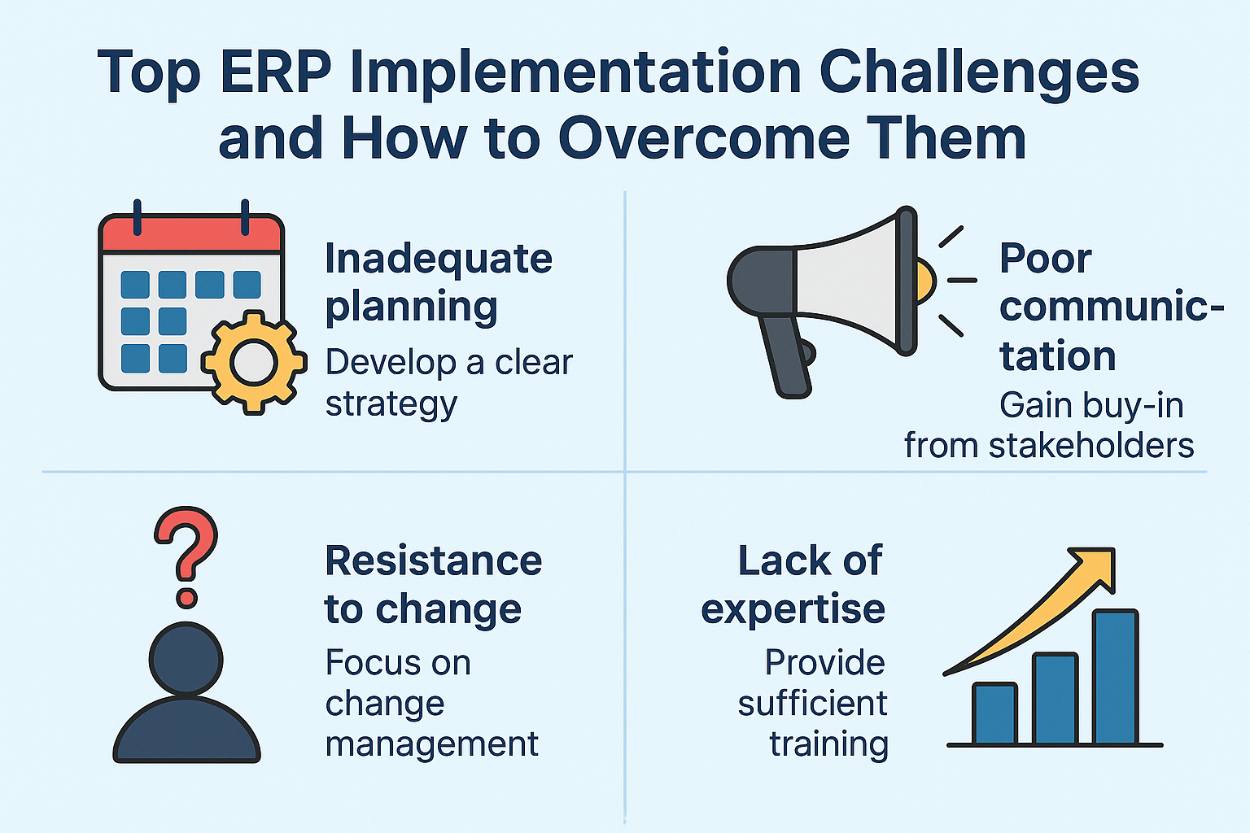Top ERP Implementation Challenges and How to Overcome Them

Enterprise Resource Planning (ERP) systems have become indispensable tools for modern businesses aiming to integrate core processes, enhance productivity, and streamline operations. However, the journey to a fully functional ERP system is often complex and riddled with challenges. Many companies underestimate the scope of the implementation process and encounter unexpected ERP problems that can derail timelines, inflate budgets, or compromise outcomes. In this article, we’ll explore the top ERP implementation challenges and provide actionable strategies to overcome them.
Inadequate Planning and Goal Setting
A major reason many ERP projects fail is due to inadequate planning. Organizations often rush into ERP deployment without clearly defining goals, key performance indicators (KPIs), or business requirements. This lack of direction leads to scope creep, misaligned expectations, and wasted resources.
Solution:
Start with a detailed project roadmap that outlines specific business needs, timelines, and measurable goals. Involve key stakeholders from the beginning to collect their insights and confirm the project supports overall strategic goals.
Lack of Executive Support
Without active backing from top management, ERP initiatives can quickly lose momentum. Executive support is crucial for securing funding, resolving internal conflicts, and promoting user adoption.
Solution:
Ensure C-suite executives are involved from the start. Their endorsement should be visible and continuous throughout the project lifecycle, reinforcing the importance of the implementation to the entire organization.
Poor Change Management
Implementing an ERP system goes beyond a simple technical upgrade — it typically demands a change in organizational culture as well. Resistance from employees, fear of job displacement, or reluctance to adopt new processes can hinder success.
Solution:
Invest in a comprehensive change management strategy that includes regular communication, training programs, and opportunities for feedback. Highlight the benefits of the new system to create buy-in across departments.
Insufficient Training
No matter how sophisticated an ERP system is, it won’t succeed if users aren’t properly trained to use it effectively. A lack of proper training can lead to errors, reduced productivity, and frustration among employees.
Solution:
Provide role-specific training tailored to different user groups. Offer both initial and ongoing education through workshops, online modules, and hands-on sessions to reinforce learning.
Data Migration Issues
Migrating data from old legacy systems to a new ERP platform is often a challenging and intricate task. Inaccurate, incomplete, or incompatible data can lead to significant disruptions post-launch.
Solution:
Audit existing data thoroughly before migration. Cleanse and standardize the information, and test the process with trial runs to identify issues early. Collaborate closely with vendors or consultants to ensure data integrity.
Customization Overload
While ERP systems are designed to be flexible, excessive customization can lead to increased complexity, higher costs, and longer implementation times. It also makes future upgrades more difficult and risky.
Solution:
Stick to out-of-the-box features whenever possible. Customize only when there’s a strong business case and ensure custom code is adequately documented. Assess if it’s more effective for business processes to align with the ERP system, instead of customizing the system to fit existing workflows.
Vendor-Client Miscommunication
Misalignment between your organization and the ERP vendor can cause project delays and unmet expectations. Ambiguities in scope, deliverables, and timelines often stem from poor communication.
Solution:
Establish a clear communication plan from day one. Clearly assign responsibilities, hold consistent progress meetings, and keep thorough documentation to support strong project management. Select a vendor with demonstrated success and experience in your specific industry.
Underestimating Post-Go-Live Support
Many organizations focus solely on going live and overlook what happens afterward. A lack of post-implementation support can leave users without guidance, allowing minor issues to snowball into major problems.
Solution:
Plan for a dedicated support phase following the launch. This should include a help desk, system monitoring, and scheduled reviews to ensure the system continues to perform as intended.
Final Thoughts
ERP implementation is a strategic investment that can yield long-term benefits – but only if executed correctly. By recognizing and proactively addressing these common challenges, companies can avoid costly missteps and ensure their ERP systems deliver maximum value. Whether you’re selecting your first ERP solution or upgrading to a new one, a well-thought-out approach grounded in best practices is key to success.
